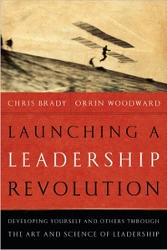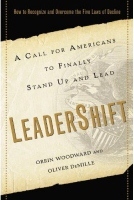The Reason for Leadership
Posted by Orrin Woodward on March 8, 2011
Here is a portion of an article on Systematic Thinking, a key tool in a leader’s arsenal. The full article is available on the TEAM site. God Bless, Orrin Woodward
The system is the tool used by the employees to provide the desired customer results without having to go through mental gymnastic every time, similar to how the subconscious mind can perform the task of driving without having to engage the full mental capacity of a trained driver. The plan is simple – develop the patterns and systems to satisfy the customer, teach the patterns and systems to the employees, and reap the harvest of satisfied customers through a duplicatable business system. Gerber teaches, “the system becomes a tool your people use to increase their productivity to get the job done. It’s your job to develop that tool and to teach your people how to use it. It’s their job to use the tool you’ve developed and to recommend improvements based on their experience with it.” In today’s competitive world, one cannot just hire hands and feet, but must engage the entire person in order to compete. A great idea to improve the system can come from anyone, and, many times, it can come from the person who is responsible for that step in the process, since they spend the most time with that particular step. Ray Stata, former CEO of Analog Devices, says, “In the traditional hierarchical organization, the top thinks and the local acts. In a learning organization, you have to merge thinking and acting in every individual.” The Japanese became famous for their system of Kaizen, recognizing and rewarding good ideas from anyone in the company who could help to improve their systems. Theodore Levitt says, “Discretion is the enemy of order, standardization, and quality.” Put in simpler terms, discretion is the enemy of duplication. Find out what works and teach it, while searching for ways to make it even better. Leaders work on the system and the team works in the system while continuously suggesting improvements to the leaders. Gerber explains the concept of orchestration, “Orchestration is based on the absolutely quantifiable certainty that people will do only one thing predictably – be unpredictable. For your business to be predictable your people must be. But if people aren’t predictable, then what? The system must provide the predictability. To do what? To give your customer what he want every single time. Why? Because unless your customer gets everything he wants every single time he’ll go someplace else to get it!”
One can quickly see that vision, purpose and work ethic, although excellent tools, are not complete without a holistic view of systems. Senge describes the dismal consequences associated with visionary leadership without a systemic mindset, “Such ‘visionary crisis managers’ often become tragic figures. Their tragedy stems from the depth and genuineness of their vision. They often are truly committed to noble aspirations. But noble aspirations are not enough to overcome systemic forces contrary to the vision. As the ecologists say, ‘Nature bats last.’ Systemic forces will win out over the most noble vision if we do not learn how to recognize, work with, and gently mold those forces.” Revealing again, the importance of a leader to be a continual learner, placing all thirteen resolutions outlined in this book into his arsenal of leadership tools. He must learn each individually, but through his systemic mindset, he realizes that the true magnifying power occurs only when viewed as a total system. Leaders learn; leaders do; leaders teach – an unbeatable cycle when adopted by all leaders within an organization. If, at any time, a leader is unwilling to confront the systemic facts, then the leader has stepped off solid ground onto the slippery slope of self delusion. Leaders can be destroyed by their vision when they refuse to learn from the facts. Senge describes the slide, “This happens, almost always, because the leaders lose their capacity to see current reality. The collude in their and their organization’s desire to assuage uneasiness and avoid uncertainty by pretending everything is going fine. The become speech makers rather than leaders.” If a leader won’t confront the brutal reality, who in the community will? In today’s hyper-competitive environment, constant innovation isn’t a nice add on, but an essential must for survival. Moreover, companies that protect their “sacred cows,” systems and culture’s that no longer serve the customer, but are held in reverence, will soon find competitors, who were more concerned with the customer’s satisfaction than a company’s “sacred cows,” eating their lunch. In fact, it could be argued that the most important system for every company is it’s innovation system, a system to discuss, dialogue and debate, ensuring that “sacred cows” are slaughtered on the altar of customer satisfaction, rather than customer satisfaction slaughtered on the altar of the “sacred cows”. Gary Hamel, in his thought provoking book, The Future of Management, wrote, “When it comes to innovation, a company’s legacy beliefs (sacred cows) are a much bigger liability than its legacy costs. Yet in my experience, few companies have a systematic process for challenging deeply held strategic assumptions. Few have taken bold steps to open up their strategy process to contrarian points of view. Few explicitly encourage disruptive innovation. Worse, it’s usually senior executives, with doctrinaire views, who get to decide which ideas go forward and which get spiked. This must change.” It’s only when the leader, by confronting brutal reality, admits the gap between where the company is and where it desires to be, that he will inspire his team to improve the systems, patterns and processes in order to win. Senge describes the leader’s most valuable role, “His relentless commitment to the truth and to inquiry into the forces underlying current reality continually highlighting the gaps between reality and the vision. Leaders generate and manage this creative tension – not just in themselves but in an entire organization. This is how they energize an organization. That is their basic job. That is why they exist.” Leaders communicate the vision while identifying the systematic causes hindering the fulfillment of it. Therefore, if a potential leader cannot think in a systematic fashion, he literally is unqualified for top leadership positions in today’s interconnected world.
Sorry, the comment form is closed at this time.







